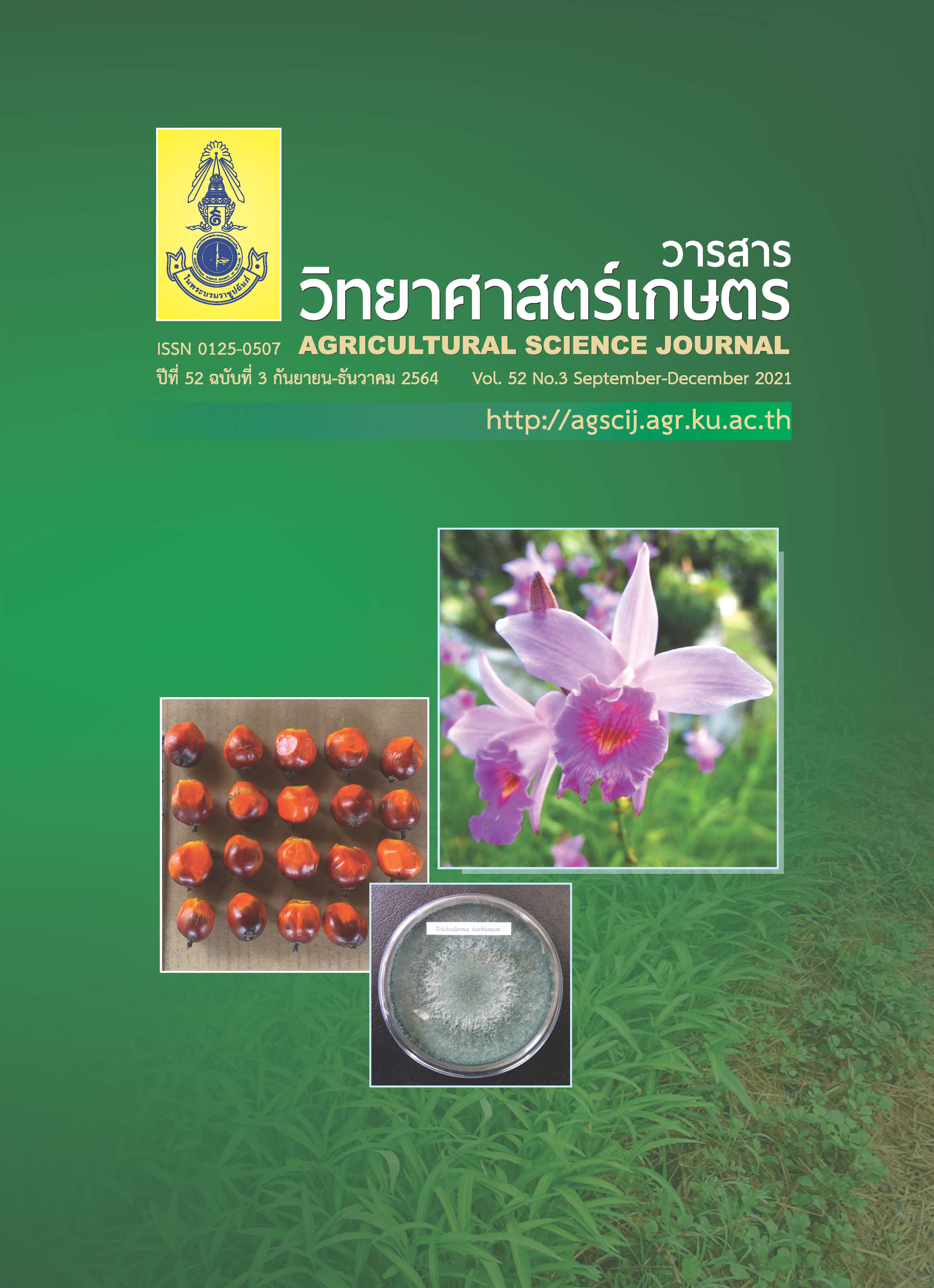อิทธิพลของเชื้อรา Trichoderma harzianum และวิธีทดสอบความงอกต่อการงอกและการเจริญเติบโตในระยะกล้าของข้าวอินดิกาและจาโปนิกา
Main Article Content
บทคัดย่อ
การใช้เชื้อราไตรโคเดอร์มาสามารถเพิ่มประสิทธิภาพความงอกและการเจริญเติบโตของข้าวในระยะกล้า อย่างไรก็ตาม การตอบสนองด้านการงอกและการเจริญเติบโตของพืชต่อความเข้มข้นของเชื้อราไตรโคเดอร์มาที่ทดสอบความงอกด้วยวิธีการทดสอบแตกต่างกัน อาจส่งผลต่อประสิทธิภาพของเชื้อราไตรโคเดอร์มา ดังนั้น การทดลองนี้จึงมีวัตถุประสงค์เพื่อทดสอบความงอกและการเจริญเติบโตของต้นกล้าข้าวอินดิกาและจาโปนิกาที่คลุกเชื้อราไตรโคเดอร์มา (T. harzianum) ชนิดผงแห้งระดับความเข้มข้นแตกต่างกันที่เพาะบนกระดาษเพาะและเพาะในดินนา วางแผนการทดลองแบบ 2 × 2 × 5 แฟคทอเรียลในแผนการทดลองแบบสุ่มสมบูรณ์ จำนวน 4 ซ้ำ ประกอบด้วย 3 ปัจจัย ได้แก่ 1) พันธุ์ข้าว 2 ประเภท คือ ข้าวอินดิกาและจาโปนิกา โดยใช้พันธุ์ทับทิมชุมแพและพันธุ์ ก.ว.ก. 2 เป็นตัวแทน ตามลำดับ 2) วิธีการเพาะ 2 วิธี คือ การเพาะบนกระดาษเพาะซ้อนกัน 3 ชั้น และการเพาะในดินนา และ 3) ระดับความเข้มข้นของเชื้อราไตรโคเดอร์มาชนิดผงแห้ง (0, 0.25, 0.50, 0.75 และ 1 กรัมต่อเมล็ด 1 กิโลกรัม) ทดสอบในห้องปฏิบัติการ เก็บข้อมูลความงอกและการเจริญเติบโตของต้นกล้าที่อายุ 14 วันหลังเพาะ คำนวณเปอร์เซ็นต์ความงอก ดัชนีความแข็งแรงของเมล็ด และดัชนีความงอกของเมล็ด ผลการทดลอง พบว่า ข้าวพันธุ์ ก.ว.ก. 2 ที่คลุกเชื้อราไตรโคเดอร์มา 0.25 กรัมต่อเมล็ด 1 กิโลกรัม เมื่อเพาะในดินนา มีการเจริญเติบโตของต้นกล้าด้านความสูงต้น ความยาวใบ และจำนวนรากมากที่สุด ขณะที่ อิทธิพลร่วมระหว่างพันธุ์ข้าวและความเข้มข้นของเชื้อราไตรโคเดอร์มาส่งผลต่อความสูงต้นและความยาวใบอย่างมีนัยสำคัญยิ่งทางสถิติ (P < 0.01) และอิทธิพลร่วมระหว่างวิธีการเพาะและความเข้มข้นของเชื้อราไตรโคเดอร์มาส่งผลต่อดัชนีความแข็งแรงของเมล็ด ความสูงต้น ความยาวใบ และความกว้างใบอย่างมีนัยสำคัญยิ่งทางสถิติ (P < 0.01) โดยเชื้อราไตรโคเดอร์มา 0.25 กรัมต่อเมล็ด 1 กิโลกรัม สามารถเพิ่มความแข็งแรงของเมล็ด ความสูงต้น ความยาวใบ ความกว้างใบ และจำนวนราก ซึ่งสามารถประยุกต์ใช้ในระบบการผลิตข้าวแบบนาหว่านได้
Article Details

อนุญาตภายใต้เงื่อนไข Creative Commons Attribution-NonCommercial-NoDerivatives 4.0 International License.
เอกสารอ้างอิง
Abdul-Baki, A.A. and J.D. Anderson. 1973. Vigor determination in soybean seed by multiple criteria. Crop Sci. 13: 630–633.
Al-Askar, A.A., A.S. Ezzat, K.M. Ghoneem and W.I.A. Saber. 2016. Trichoderma harzianum WKY5 and its gibberellic acid control of Rhizoctonia solani, improve sprouting, growth and productivity of potato. Egypt. J. Biol. Pest Control. 26(4): 787–796.
Al-Sharmani, H.R., H.H. Al-Kalabi and A.N. Al-Abedy. 2019. Efficacy of rice husks compost and Trichoderma harzianum on Rhizoctonia solani and its effect on seeds germination and seedling health. IOP Conf. Ser.: Earth Environ. Sci. 388: 012002.
Anhar, A., N.P. Sari, L. Advinda, D.H. Putri and D. Handayani. 2019. Effect of the indigenous Trichoderma application on germination of black glutinous rice seed. J. Phys.: Conf. Ser. 1317: 012065.
Anis, M., M.J. Zaki and M.W. Abbasi. 2013. Effect of seed coating with Trichoderma species on colonization of Macrophomina phaseolina and the growth of sunflower under field conditions. Int. J. Biol. Biotech. 10(2): 207–212.
Asaduzzaman, M., M.J. Alam and M.M. Islam. 2010. Effect of Trichoderma on seed germination and seedling parameters of chili. J. Sci. Foundation. 8(1–2): 141–150.
Bezuidenhout, J., L.V. Rensburg and P.J.V. Rensburg. 2012. Molecular similarity between gibberellic acid and gliotoxin: unravelling the mechanism of action for plant growth promotion by Trichoderma harzianum. J. Agric. Sci. Technol. B. 2: 703–712.
Chamswarng, C., W. Intanoo and T. Kumchang. 2001. Efficacy of various formulations of Trichoderma harzianum for controlling stem rot of yardlong bean caused by Sclerotium rolfsii, pp. 236–242. In Proc. the 39th Kasetsart University Annual Conference, 5–7 February 2001. (in Thai)
Doni, F., C.R.C. Mohd Zain, A. Isahak, F. Fathurrahman, N. Sulaiman, N. Uphoff and W.M.W. Yusoff. 2017. Relationships observed between Trichoderma inoculation and characteristics of rice grown under System of Rice Intensification (SRI) vs. conventional methods of cultivation. Symbiosis. 72: 45–59.
Doni, F., I. Anizan, C.M.Z. Che Radziah, A.H. Salman, M.H. Rodzihan and W.M.W. Yusoff. 2014. Enhancement of rice seed germination and vigour by Trichoderma spp. Res. J. App. Sci. Eng. Technol. 7(21): 4547–4552.
Hermosa, R., A. Viterbo, I. Chet and E. Monte. 2012. Plant-beneficial effects of Trichoderma and of its genes. Microbiology. 158: 17–25.
Intana, W., A. Promwee and P. Yenjit. 2018. Increasing the efficacy to control narrow brown spot of rice using combination of Trichoderma asperellum NST–009 and Bacillus subtilis NST–002. Agricultural Sci. J. 49(2): 147–159. (in Thai)
Islam, M.S., M.A. Rahman, S.H. Bulbul and M.F. Alam. 2011. Effect of Trichoderma on seed germination and seedling parameters in chili. Int. J. Expt. Agric. 2(1): 21–26.
ISTA (International Seed Testing Association). 2014. International Rules for Seed Testing. International Seed Testing Association, Bassersdorf, Switzerland.
Khadka, R.B. and N. Uphoff. 2019. Effects of Trichoderma seedling treatment with System of Rice Intensification management and with conventional management of transplanted rice. PeerJ. 7: e5877.
Khan, A.A., A.P. Sinha and Y.P.S. Rathi. 2005. Plant growth promoting activity of Trichoderma harzianum on rice seed germination and seedling vigor. Indian J. Agric. Res. 39(4): 256–262.
Kumar, V., M. Shahid, M. Srivastava, A. Singh, S. Pandey and A. Sharma. 2014. Enhancing seed germination and vigor of chickpea by using potential and effective strains of Trichoderma species. Virol. & Mycol. 3(2): 128.
Mukhtar, A. 2008. Influence of Trichoderma species on seed germination in okra. Mycopath. 6(1–2): 47–50.
Saengkai, K., S. Amkha and P. Rungcharoenthong. 2017. Efficacy Trichoderma asperellum CB–Pin–01 and calcium silicate to seed germination and control stem rot caused by Sclerotium rolfsii in Capsicum annuum cv. ‘Bangchang’. Thaksin. J. 20(3): 86−94. (in Thai)
Soyyot, P., T. Pongkumpun, J. Boonrawd, D. Thawornchareon and J. Sreesaeng. 2019. Efficiency of Trichoderma fungus and growing media on growth of Dendrobium Sonia “Red Joe” derived from tissue culture. Agricultural Sci. J. 50(1): 10–22. (in Thai)
Umadi, S.S., Sumadi and D.S. Sobarna. 2018. The effect of seed coating with Trichoderma sp. and application of bokashi fertilizer to the quality of soybean (Glycine max. L) seed. Jurnal Biodjati. 3(2): 110–117.
Vinale, F., K. Sivasithamparam, E.L. Ghisalberti, R. Marra, M.J. Barbetti, H. Li, S.L. Woo and M. Lorito. 2008. A novel role for Trichoderma secondary metabolites in the interactions with plants. Physiol. Mol. Plant Pathol. 72: 80–86.


